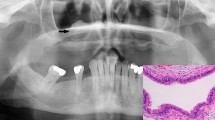Abstract
We report on a child who presented clinical manifestations of both neurofibromatosis type 1 (NF1) and cherubism. With genetic testing, we found a mutation in the NF-1 gene, confirming the neurocutaneous disorder. Histology when correlated with radiological evaluation of a mandibular biopsy was consistent with cherubism. This is the first report in the literature of a child with proven neurofibromatosis type 1 and cherubism without extragnathic lesions. This emphasises that cherubism is a clinical phenotype that can be associated with a number of germline mutations involving SH3BP2, PTPN11 and NF1.





Similar content being viewed by others
References
Addante RR, Breen GH (1996) Cherubism in a patient with Noonan’s syndrome. J Oral Maxillofac Surg 54:210–213
Ardekian L, Manor R, Peled M, Laufer D (1999) Bilateral central giant cell granulomas in a patient with neurofibromatosis : report of a case and review of the literature. J Oral Maxillofac Surg 57(7):869–872
Ayoub AF, El-Mofty SS (1993) Cherubism: report of an aggressive case and review of the literature. J Oral Maxillofac Surg 51:702–705
Buehning L, Curry CJ (1995) Neurofibromatosis-Noonan syndrome. Pediatr Dermatol 12:267–271
Cohen MM Jr, Gorlin RJ (1991) Noonan-like/multiple giant cell lesion syndrome. Am J Med Genet 40:159–166
Colby RS, Saul RA (2003) Is Jaffe-Campanacci syndrome just a manifestation of neurofibromatosis type 1? Am J Med Genet 123(1):60–63
DeBella K, Szudek J, Friedman JM (2000) Use of the national institutes of health criteria for diagnosis of neurofibromatosis 1 in children. Pediatrics 105(3 Pt 1):608–614
De Lange J, van den Akker HP (2005) Clinical and radiological features of central giant-cell lesions of the jaw. Oral Surg Oral Med Oral Pathol Oral Radiol Endod 99(4):464–470
DeTomasi DC, Hann JR, Stewart HM Jr (1985) Cherubism, report of a nonfamilial case. J Am Dent Assoc 111(3):455–457
Dunlap C, Neville B, Vickers RA, O’Neil D, Barker B (1989) The Noonan syndrome/cherubism association. Oral Surg Oral Med Oral Pathol 67(6):698–705
Fahsold R, Hoffmeyer S, Mischung C, Gille C, Ehlers C, Kucukceylan N, Abdel-Nour M, Gewies A, Peters H, Kaufmann D, Buske A, Tinschert S, Nurnberg P (2000) Minor lesion mutational spectrum of the entire NF1 gene does not explain its high mutability but points to a functional domain upstream of the GAP-related domain. Am J Hum Genet 66:790–818
Han SS, Cooper DN, Upadhyaya MN (2001) Evaluation of denaturing high performance liquid chromatography (DHPLC) for the mutational analysis of the neurofibromatosis type 1 (NF1) gene. Hum Genet 109:487–497
Jafarov T, Ferimazova N, Reichenberger E (2005) Noonan-like syndrome mutations in PTPN11 in patients diagnosed with cherubism. Clin Genet 68:190–191
Kaugars GE, Niamtu J III, Svirsky JA (1992) Cherubism: diagnosis, treatment and comparison with central giant cell granulomas and giant cell tumors. Oral Surg Oral Med Oral Pathol 73:369–374
Krammer U, Wimmer K, Wiesbauer P, Rasse M, Lang S, Mullner-Eidenbock A, Frisch H (2003) Neurofibromatosis 1: a novel NF1 mutation in an 11-year-old girl with a giant cell granuloma. J Child Neurol 18(5):371–373
Li CY, Yu SF (2006) Mutation detection in SH3BP2 gene in a cherubism family. Zhonghua Kou Qiang Yi Xue Za Zhi 41:368–371
Lietman SA, Kalinchinko N, Deng X, Kohanski R, Levine MA (2006) Identification of a novel mutation of SH3BP2 in cherubism and demonstration that SH3BP2 mutations lead to increased NFAT activation. Hum Mutat 27:717–718
Lo B, Faiyaz-Ul-Haque M, Kennedy S, Aviv R, Tsui LC, Teebi AS (2003) Novel mutation in the gene encoding c-Abl-binding protein SH3BP2 causes cherubism. Am J Med Genetics 121:37–40
Imai Y, Kanno K, Moriya T, Kayano S, Seino H, Matsubara Y, Yamada A (2003) A missense mutation in the SH3BP2 gene on chromosome 4p16.3 found in a case of nonfamilial cherubism. Cleft Palate Craniofac J 40:632–638
Mangion J, Rahman N, Edkins S, Barfoot R, Nguyen T, Sigurdsson A, Townend JV, Fitzpatrick DR, Flanagan AM, Stratton MR (1999) The gene for cherubism maps to chromosome 4p16.3. Am J Hum Genet 65(1):151–157
Martinez-Tello FJ, Manjon-Luengo P, Martinez-Perez M, Montes-Moreno S (2005) Cherubism associated with neurofibromatosis type 1, and multiple osteolytic lesions of both femurs: a previously undescribed association of findings. Skeletal Radiol 34(12):793–798
Mirra JM, Gold RH, Rand F (1982) Disseminated nonossifying fibromas in association with café-au-lait spots (Jaffe-Campanacci syndrome). Clin Orthop Relat Res (168):192–205
Neurofibromatosis. Conference statement. National Institutes of Health Consensus Development Conference (1988) Arch Neurol 45(5):575–578
Ruggieri M, Pavone V, Polizzi A, Albanese S, Magro G, Merino M, Duray PH (1999) Unusual form of recurrent giant cell granuloma of the mandible and lower extremities in a patient with neurofibromatosis type 1. Oral Surg Oral Med Oral Pathol Oral Radiol Endod 87:67–72
Sarkozy A, Obregon MG, Conti E, Esposito G, Mingarelli R, Pizzuti A, Dallapiccola B (2004) A Novel PTPN11 gene mutation bridges Noonan syndrome, multiple lentigines/LEOPARD syndrome and Noonan-like/multiple giant cell lesion syndrome. Eur J Hum Genet 12:1069–1072
Shen MH, Harper PS, Upadhyaya M (1996) Molecular genetics of neurofibromatosis type 1 (NF1). J Med Genet 33(1):2–17
Southgate J, Sarma U, Townend JV, Barron J, Flanagan AM (1998) Study of the cell biology and biochemistry of cherubism. J Clin Pathol 51(11):831–837
Ueki Y, Tiziani V, Santanna C, Fukai N, Maulik C, Garfinkle J, Ninomiya C, doAmaral C, Peters H, Habal M, Rhee-Morris L, Doss JB, Kreiborg S, Olsen BR, Reichenberger E (2001) Mutations in the gene encoding c-Abl-binding protein SH3BP2 cause cherubism. Nat Genet 28:125–126
Van Damme PA, Mooren RE (1994) Differentiation of multiple giant cell lesions, Noonan-like syndrome, and (occult) hyperparathyroidism. Case report and review of the literature. Int J Oral Maxillofac Surg 23(1):32–36
Author information
Authors and Affiliations
Corresponding author
Rights and permissions
About this article
Cite this article
van Capelle, C.I., Hogeman, P.H.G., van der Sijs-Bos, C.J.M. et al. Neurofibromatosis presenting with a cherubism phenotype. Eur J Pediatr 166, 905–909 (2007). https://doi.org/10.1007/s00431-006-0334-6
Received:
Accepted:
Published:
Issue Date:
DOI: https://doi.org/10.1007/s00431-006-0334-6




